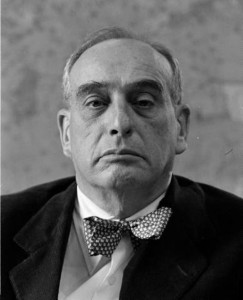
Photo above: Robert Moses, October 1952 by Alfred Eisensteadt (Courtesy Google Life)
PODCAST: EPISODE 100 We obviously had to spend our anniversary show with the Power Broker himself, everybody’s favorite Parks Commissioner — Robert Moses.
A healthy debate about Moses will divide your friends, and we provide the resources to make your case for both sides. Robert Moses was one of the most powerful men in New York from the late 1920s until the late 1960s, using multiple appointed positions in state and local government to make his vast dream of a modern New York comes to fruition.
That dream included glorious parkways and gravity-defying bridges. It also included parking lots and the wholesale destruction of thousands of homes. World’s fairs and innovative housing complexes. Elevated highways plowed through residential neighborhoods — straight through Harlem, midtown Manhattan, and SoHo.
We get into the trenches of some of Moses’s most renown and controversial projects — the splendor of Jones Beach; the revolutionary parks and pools; the tragedy of the Cross Bronx Expressway, and his signature project, the Triborough Bridge.
What side will you come down on — did Robert Moses give New York City the resources it needs to excel in the 20th century, or did he hasten its demise with short-sighted, malignant vision?
You can tune into it below, download it for FREE from iTunes or other podcasting services, get it straight from our satellite site.
CORRECTION TO THIS WEEK’S PODCAST: Once again, a misinterpretation of my own handwritten notes creates a somewhat hilarious mistake this time around. Although Jones Beach was indeed truly popular in its first year, it did not see an attendance of 150 million people in its first year. (That would have been more people than lived in the entire United States.) The correct number is 1.5 million.
___________________________________________________
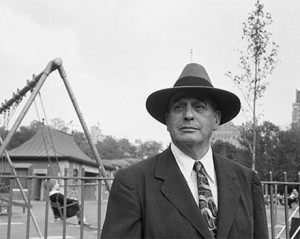
KING OF PARKS: As the first five-borough Parks Commissioner, Moses was responsible for the creation and renovation of hundreds of city parks. If you see a park in New York, Robert Moses either commissioned it or radically altered it. Shunning the ‘waste’ of natural beauty, Moses replaced groves and meadows with tennis courts, playgrounds, drinking fountains and other things made with concrete and asphalt.
ALL WET: Being a swimmer himself, Moses placed an emphasis on public pools throughout the city, including this one in Astoria, Queens. For pools in East Harlem where he wanted to encourage white attendence, Moses reportedly authorized that the temperature of the water made colder — because black people disliked cold water. (Um, Bob, nobody likes cold water.)
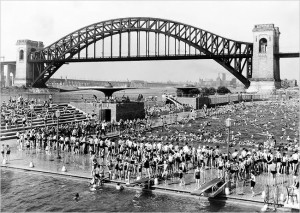
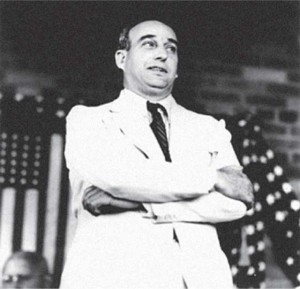
CAN’T LIVE WITH ‘EM….: Mayors and governors alike latched onto Moses’s remarkable progress; newspaper editors and community leaders fell over each other to praise him. Voices of dissension were few and ignored. By the 1940s, he was immensely powerful, leading at one point a dozen local and state commissions and authorities. Picture from August 18, 1937. (Courtesy of the Long Island State Park Region Photo Archive)
BRIDGE TO NOWHERE: Moses with a model of his Brooklyn Battery Bridge, which would have cut straight over New York Harbor, linking Battery Park with Red Hook, Brooklyn. To build this monstrosity would require turning Governor’s Island into a gigantic anchorage and eradicating the New York Aquarium, housed in historic Castle Clinton.
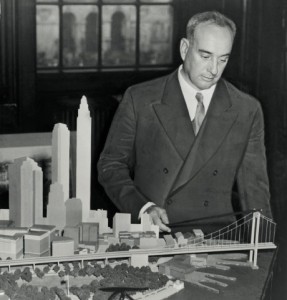
The project was defeated by some backroom machinations from President Roosevelt, but Moses got his revenge — on the New York Aquarium. He ripped it out of Castle Clinton and threw it out on Coney Island.
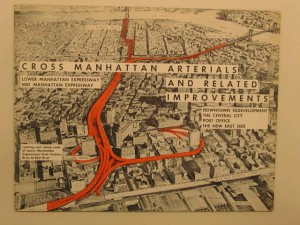
HIGHWAY CITY: Had Moses’s ideas come to full fruition, an elevated highway would have cut through lower Manhattan at Broome Street, a mid-Manhattan version would have landed onto 30th Street, and the culture of Harlem’s 125th Street would have been eliminated by a Cross Harlem Expressway. The two uptown extensions died quickly, but Moses was so close to making LoMaX (the Lower Manhattan Expressway) that one segment, at Chrystie Street, was actually built and abandoned.
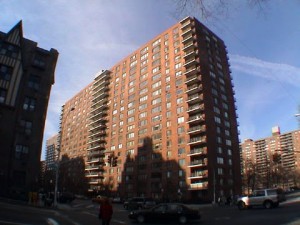
SCANDAL: The drab structures at Park West Village belie the scandal of Manhattantown, a proposed development exposed as an elaborate development scam spawned from the federal government Slum Clearance Program — a program overseen by Moses in New York.
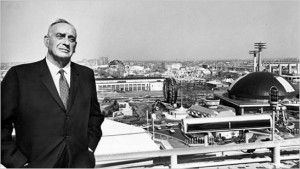
NO FAIR: A visibly bitter Moses stands aloft his World’s Fair of 1964-65, a chaotic, financial flop that gave the press, once so adoring of their former Parks Commissioner, ample fodder for mockery.
Robert Moses has divided urban planners, politicians and regular New Yorkers for decades. The 1970s saw the devastating bio The Power Broker by Robert Caro, elaborating in great, grim detail the evils of Moses’s decisions. His legacy was re-evaluated in a critical 2007 exhibition at the Queens Museum.
Photo by Alfred Eisensteadt (Courtesy Google Life)

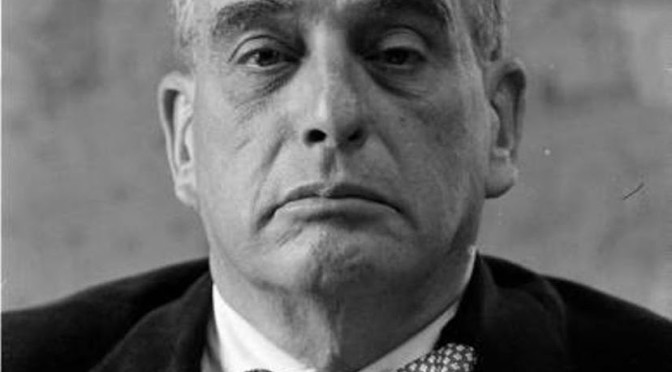
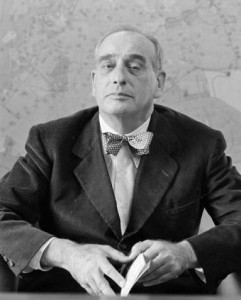
10 replies on “Robert Moses: Did he save New York — or destroy it?”
Greg and Tom:
I love love love your podcasts. I listen to them when I take my breaks at work at the Journalism school in Columbia Missouri….remind anyone of their old school days Tom.
I was telling a customer of mine about your podcasts and ran into Ben whom told me that he worked for Greg at Eurocheapo, and now we are friends.
Anyway…love you guys and keep bringing out those gems of NY…
Colleen Thomas….
I have a blog too…www.beadnfun.wordpress.com
check it out.
Ben and I will be sending you some photos of us this week.
Hi, Greg and Tom! Today I finally listened to the 100th Episode. I was saving it for a special occasion. And it definitely lived up to expectation! I have recommended your podcast to all my friends!
Great, as always!
I nominate Robert Moses or even Peter Stuyvesant, as the official Bowery Boys mascot. It would be a difficult choice between the two.
I teach NYC History to high school seniors and find your podcasts invaluable! Could you please do a podcast on his nemesis Jane Jacobs?
great idea!
I’ve actually listened to this podcast 3 or 4 times (I do follow you guys so it’s not just this one in particular) but this one stroke me as one of your best probably because of the subject. You picked probably one of the most hated characters but the truth is Manhattan and New York would not be the busy, cosmopolitan centre of the world we know without him. So, in a way he shaped New York to be what it is and I think we’re all grateful for that, right?
I have yet to listen to the podcast (I will, I just discovered it), but I read the Power Broker years ago, and the two things I will never forgive him for is the VN Bridge, that prevented a subway link to Staten Island, and his preventing public transit to the airports…
Being French and not a specialist of urbanism issues , I have to confess that I ignored the existence of Robert Moses until recently.
The reason why I’m posting this message is that I actually first came across this important figure of NY history thanks to a recent and awesome French graphic novel by Pierre Christin & Olivier Balez which happen to be also available in an English version thanks to an English editor Nobrow: http://www.nobrow.net/16678
For those who understand French, you may also listen to an interview of Pierre Christin about this book and Robert Moses in a recent weekly program dedicated to America’s history on French Public Radio: http://www.franceinter.fr/emission-si-lamerique-metait-contee-episode-27-skyline-buildings-et-statue-de-la-liberte-l-architect
Thank you for your podacsts in general
I wouldn’t be surprised if Christin and Balez had listened to it when preparing their book!
Philippe
[…] Bowery Boys History: Robert Moses, Mar. 19, 2010 […]
I read an article that cheekily reffered to Robert Moses as the grandfather of hiphop (due to the CBX clearance of organic neighborhoods, leading to the poverty and despair of the 1970s.